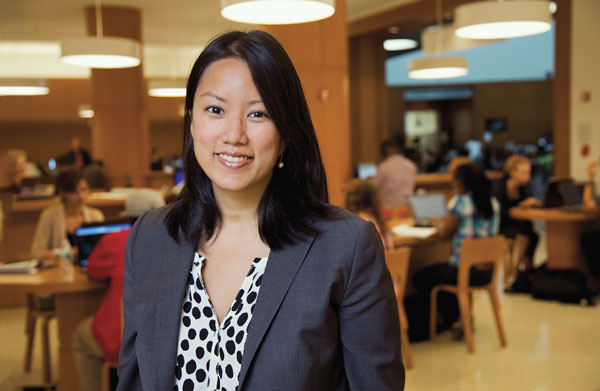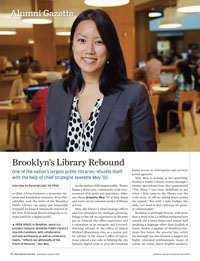Alumni Gazette
 OPEN SPACE: In Brooklyn, space is a precious resource. Brooklyn Public Library’s new Info Commons, with collaborative and solo workspaces as well as conference rooms, “reflects our philosophy of the future of libraries,” says Moy. (Photo: Shannon Taggart for Rochester Review)
OPEN SPACE: In Brooklyn, space is a precious resource. Brooklyn Public Library’s new Info Commons, with collaborative and solo workspaces as well as conference rooms, “reflects our philosophy of the future of libraries,” says Moy. (Photo: Shannon Taggart for Rochester Review)In 2010, Linda Johnson, a seasoned MUseum and foundation executive from Philadelphia, took the helm of the Brooklyn Public Library—an aging and financially strapped 60-branch behemoth ordered by the New York State Board of Regents to remake itself for a digital world.
As the nation’s fifth largest public library began a three-year, community-wide reassessment of its goals and operations, Johnson chose Jeanette Moy ’02 to help shape and carry out its retooled model of library service.
Moy, the library’s chief strategy officer and vice president for strategic planning, brings to the job no experience in libraries per se. Instead, she offers experience and a reputation as an energetic and forward- thinking advisor in the office of Mayor Michael Bloomberg who, as a senior policy advisor in the mayor’s office of operations, played a key role in helping the city harness digital tools to provide residents better access to information and services across agencies.
Now Moy is looking at the sprawling, Brooklyn Public Library system through a similar operational lens. Her assessment? “The thing I was most delighted to see when I first came to the library was the wide array of efforts taking place across the system.” But with a tight budget, she adds, “we need to find pathways for greater collaboration.”
Brooklyn is strikingly diverse, with more than a third of its 2.5 million residents born outside the United States and almost half speaking a language other than English at home. Nearly a quarter of Brooklyn residents live below the poverty line, while the borough has also become a magnet for highly educated professionals, many of whom are white, native English speakers, and newcomers to New York City.
“Much has been made in the media about the dichotomy between ‘old Brooklyn’ and ‘new Brooklyn,’ ” says Moy, using the labels with some hesitation. A native of Flushing, Queens, who lives in nearby Oakland Gardens with her husband and two daughters, Moy travels easily among diverse circles. Rooted in a predominantly immigrant community in the outer boroughs, she attended the storied public magnet school, Stuyvestant High School in Manhattan. She came to Rochester to study political science and public policy.
Has the basic mission of the Brooklyn Public Library changed?
The library has always been a physical place where local communities gather and access information, and each branch has been an independent library in and of itself. But increasingly, the library is relied upon for a range of educational and social services that extend far beyond providing access to books. Our patrons need more personal support from our staff than ever. Our librarians now have to serve as curators of a dizzying array of information, promoters of literacy at all levels, and referral points for social services, which are in much higher demand than we’ve ever seen before.
How are these pressures changing how you operate?
In the past, our branch professionals have spent an incredible amount of time behind the scenes managing collections—selecting, ordering, purchasing and processing materials—and also managing fine collection, cash boxes, and tracking lent materials.
We’ve helped by doing away with many of the time-consuming processes related to managing collections. Any patron can use a self-serve kiosk to check out materials, swipe a card to reserve a personal computer, and find most of our collection through a digital tool—online, on a mobile device, and in one of five languages. We’ve also implemented a floating collection. Patrons can return books at any of our 60 locations, and they will stay at that library. Over time, local community preferences start to shape the branch’s collection.
These changes have allowed our staff to spend more time with our patrons, and frankly freed up a ton of administrative space for public use.
Which services are in greatest demand?
In terms of the demand for social services, there are many individuals in our libraries who are unemployed or underemployed, lack a permanent residence, or may need to find mental health services. But usage varies tremendously by neighborhood. For instance, some of our branches that have the highest circulation—what the library has traditionally used as a metric of success—are in areas with large concentrations of immigrants. In other sites where you have low access to broadband, you have a lot of people coming in to use computers. In many communities with higher poverty levels, branches are community centers and safe spaces.
How is the library using space in new ways?
In January, we opened the Shelby White and Leon Levy Information Commons in the central library, in the space that formerly housed our popular collection. Not one book or magazine can be found in this space. Instead, we offer computers equipped with professional-grade software, conference rooms for public training, a media lab, and plenty of space for collaborative work and learning.
We’ve partnered with a local organization called BRIC [formerly Brooklyn Arts Media]. They’re providing digital media training to patrons on site, helping us build a bridge between the people who are at the cutting edge of technology and those who are learning the basics.
The Info Commons reflects our philosophy of the future of libraries: it’s not just a matter of accessing the books, but rather a focus on how people learn, as well as how people access, and even create, content. Throughout the rest of the library, there are many other places where a patron can access physical materials. This is a space dedicated for people to work, learn, and create, and to promulgate everything they’ve learned to the rest of the community.
We’re seeing what works within the Info Commons, and if it’s a model that we can bring to other sites.
Given Brooklyn’s wide disparities in wealth and education, how do you remain an essential resource for the entire community?
It’s true that we have many neighborhoods in Brooklyn that don’t have access to high-speed broadband, a basic requirement for access to information in our increasingly digital world, while these neighborhoods are often right across the street from the most expensive zip codes in the city.
In many parts of Brooklyn, there are simply amazing content creators, who are very in line with the concepts of open data and information for all—values that align nicely with a public library. So we should be asking ourselves, how could those individuals bring their skills back to other parts of Brooklyn? Our partnership with BRIC, which has recently expanded beyond the central library to other branches, is one answer.
At the same time, affluent and well-educated patrons continue to be big users of the library. In Park Slope, for example, which is a fairly affluent neighborhood, our Mommy and Me story times are probably one of the hottest tickets in the neighborhood.

